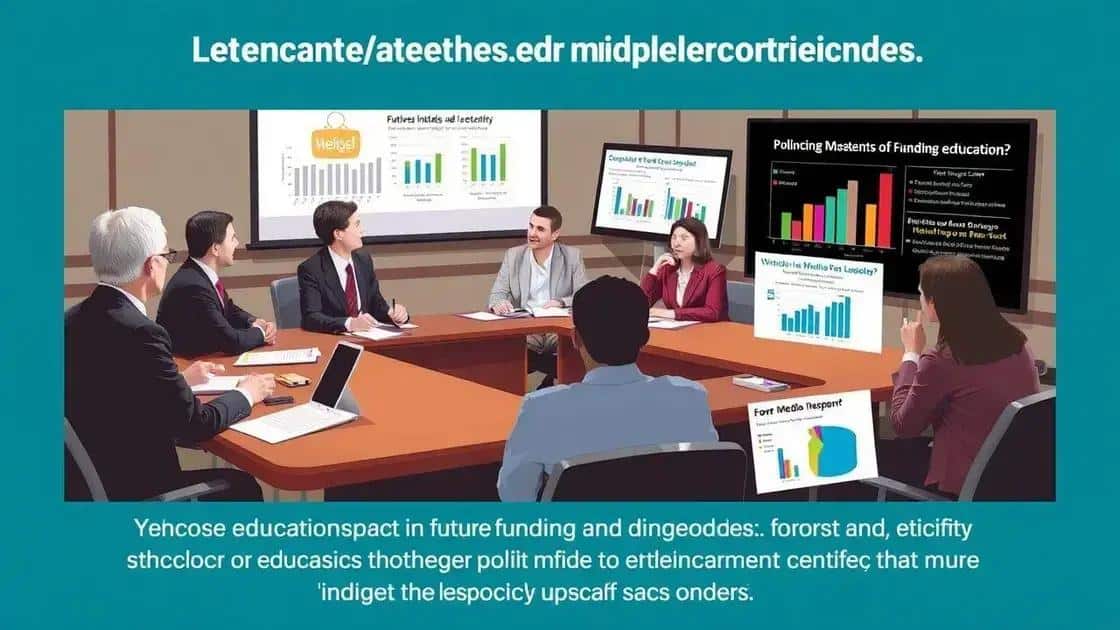$3M for Iraqi Sesame Street? Discover the shocking expenses
Anúncios
The $3M for Iraqi Sesame Street aims to enhance children’s education through engaging media, illustrating the importance of community involvement and innovative funding in early childhood learning.
$3M for Iraqi Sesame Street? This staggering figure raises questions about how funds are being spent in children’s education. Have you ever wondered about the effectiveness of such expenditures?
Overview of Sesame Street’s impact in Iraq
When discussing the impact of Sesame Street in Iraq, it’s essential to recognize how this beloved program has influenced children’s education and cultural understanding. Since its introduction, the show has played a significant role in promoting educational values and fostering communication among young viewers.
Key Educational Benefits
Sesame Street offers various educational benefits that are crucial for a developing society. These include:
- 📚 Improving language skills: Children learn new words and expressions.
- 🤝 Encouraging social skills: The characters model sharing, friendship, and teamwork.
- 🧠 Enhancing critical thinking: The show prompts children to solve problems and think creatively.
Moreover, the show addresses real-life issues that children face, allowing them to better understand their environment. This approach is vital in a region where children often encounter conflict and uncertainty.
Cultural Relevance
The cultural elements integrated into Sesame Street help children from diverse backgrounds relate to the stories. The program features local traditions and values, which fosters a sense of identity among young viewers.
As children experience these narratives, they start to develop emotional literacy, learning how to express their feelings and cope with challenges. Such content is particularly important in nations where emotional well-being may often be overlooked.
Alongside education, the portrayal of positive role models inspires children to pursue their dreams. The characters resonate with their experiences, encouraging them to aspire toward a better future.
Community Involvement
Community engagement is another essential aspect of Sesame Street’s impact in Iraq. Workshops and programs encourage mothers and caregivers to participate in their children’s learning journey. This involvement ensures that the lessons learned on screen translate into everyday life.
It’s important to note that the collaboration with local educators further enriches the content. By incorporating local insights, the show continually adapts to the needs of its audience.
Exploring the $3M allocation: A breakdown

The $3M allocation for Iraqi Sesame Street raises critical questions about fund utilization. Let’s take a closer look at how this money is being allocated.
Budget Overview
The overall budget breakdown is essential to understand where the funds go. Key areas of investment include:
- Program development and content creation.
- Community outreach initiatives.
- Training local educators and staff.
- Production costs for high-quality episodes.
Each of these components plays a vital role in ensuring that the program can deliver educational content effectively. This budget not only supports the production of episodes but also fosters community engagement, which is crucial for its success.
Impact Assessment
Assessing the impact of this allocation becomes necessary to ensure accountability. Studies show that educational programs lead to:
- Increased literacy rates among children.
- Improved social skills and emotional intelligence.
- Greater community involvement in children’s education.
By focusing on these areas, the allocated budget aims to provide long-term benefits to children and communities in Iraq.
Furthermore, transparency in spending is paramount. Parents and educators want to know how these funds directly impact their communities. Ensuring clear communication about the allocation helps build trust and support for the program.
Challenges in Execution
Despite the positive aspects, there are challenges associated with managing such a significant budget. Fluctuations in local economic conditions can affect the stability of funding. Additionally, aligning the program’s needs with available resources often requires adjustments and flexibility.
Stakeholders must work collaboratively to overcome these challenges. Active participation from local communities can help identify needs and streamline spending processes, ensuring that the program remains effective and impactful.
Previous controversial expenditures in education
Examining previous controversial expenditures in education helps shed light on the complexities surrounding funding decisions. Over the years, there have been several instances where education spending has become a topic of heated debate.
Notable Examples
One relevant case includes the misallocation of funds that were intended for educational resources. This has impacted schools and students adversely. Some notable examples of such controversies are:
- 💸 Funding designated for new textbooks never reaching the classrooms.
- 🏗️ Money intended for facilities being diverted to unrelated projects.
- ⚖️ Inequitable distribution of resources among different regions, leading to disparities.
These examples show how mismanagement can lead to wasted potential in a country where education is crucial for development.
Community Reactions
The community’s response to these expenditures reveals the desire for transparency and accountability. Parents and local leaders often voice their concerns about how funds are used. When expenditures do not align with educational needs, public trust erodes.
Moreover, when communities see significant funds being misallocated, it can lead to protests and calls for reform. Residents want assurance that their taxpayer dollars are going towards improving education.
Potential Solutions
Recognizing past mistakes is vital in shaping future spending policies. One potential solution is improving oversight and governance of educational budgets. Training for local education officials can also ensure that spending aligns with community needs.
Additionally, involving community members in budget discussions can create a more engaged and informed public. This also fosters a sense of ownership over educational outcomes, ultimately benefiting students.
Public reactions and media coverage

Public reactions and media coverage surrounding the $3M for Iraqi Sesame Street funding have sparked significant debate. Many people have expressed their opinions about the allocation of such a large sum for children’s programming.
Media Coverage
The reaction from the media has been varied. Some outlets have praised the initiative for its potential impact on children’s education. They highlight how Sesame Street can provide valuable lessons in literacy and social skills.
Others, however, question the necessity of spending $3M on a television program when there are pressing issues like inadequate school infrastructure. This mixed coverage reflects diverse public sentiments and concerns about education funding priorities.
Community Responses
In local communities, reactions have been heated and passionate. Supporters of the program argue that investing in early childhood education is essential. They believe that successful educational programs can change lives and benefit society as a whole.
Conversely, critics feel that the funds could be better utilized for direct educational resources. They voice their concerns about the lack of transparency regarding how the money is spent and the potential for mismanagement.
- Supporters advocate for educational innovation.
- Critics demand accountability and clarity in spending.
- Public forums have become platforms for expressing views.
Feedback on social media has also played a crucial role. Many discussions highlight the importance of ensuring every dollar spent creates real benefits for children. Parents and educators often share personal experiences, emphasizing the importance of transparency in educational funding.
Overall, the reactions reflect a community that is deeply invested in children’s education and its future. As discussions continue, it becomes clear that public engagement is vital in shaping decisions about educational priorities.
Comparative analysis with other spending projects
Conducting a comparative analysis with other spending projects is essential to understand the significance of the $3M for Iraqi Sesame Street. By looking at similar initiatives, we can gain insights into budgeting priorities and outcomes.
Comparison with Educational Investments
Many countries have various educational projects that address similar goals. For instance, programs aimed at enhancing childhood education often allocate funds differently. Some key examples include:
- 🏫 Investments in school infrastructure that directly impact learning environments.
- 📚 Funding for teacher training programs to improve educational quality.
- 👨👩👧👦 Resources for community engagement initiatives that involve parents and caregivers.
When compared to these projects, the funding for Sesame Street raises questions about the cost-effectiveness of using television as an educational tool versus direct investment in schools. The focus on media can be beneficial, but it may not replace the necessity of improving physical educational settings.
Impact Assessment of Similar Projects
Exploring similar media-based initiatives shows a mix of successes and challenges. Projects like Blue’s Clues and Mister Rogers’ Neighborhood demonstrate how television can engage children and support learning. Each program has its unique impact:
- Increased literacy rates: Programs have reported boosts in early reading skills.
- Social skills development: Children learn about emotions and relationships through characters.
- Global reach: Educational programs often expand beyond their home countries.
These successful examples highlight that while the $3M investment is significant, it should be evaluated alongside other educational funding to determine its effectiveness and overall contributions to children’s learning.
In addition, transparency in comparisons can help ensure that funding decisions serve the best interests of students. It is crucial for stakeholders to analyze the results of various spending initiatives to support informed decision-making in education.
What this means for future funding initiatives

Understanding what the $3M for Iraqi Sesame Street means for future funding initiatives is crucial for educators, policymakers, and community leaders. This funding is not just about a television program; it represents a potential shift in how educational resources are allocated.
Influencing Funding Allocations
The decision to invest such a significant amount in a media initiative could lead to more funding for similar projects in the future. Successful implementation and positive outcomes may set a precedent, encouraging stakeholders to prioritize educational media as a valuable tool.
Key considerations include:
- The need for measurable impacts on children’s education.
- How similar projects can be funded based on success stories.
- The importance of allocating resources to develop educational content that engages young audiences.
This approach could reshape future funding practices, urging decision-makers to explore innovative educational methods beyond traditional schooling.
Community Engagement and Support
Community engagement is vital for the success of any educational initiative. By investing in projects like Sesame Street, funders can demonstrate their commitment to early childhood education. This creates a framework for collaboration between communities, educators, and policymakers.
As communities see positive changes brought about by media initiatives, they may advocate for continued investment. This cycle of support can lead to:
- Increased local and national funding.
- More partnerships between educational organizations and media companies.
- Greater involvement of parents and caregivers in educational programming.
When communities feel invested in educational projects, it enhances the sustainability of funding initiatives, paving the way for long-term benefits.
Long-Term Educational Outcomes
Ultimately, the implications of this funding extend beyond immediate educational improvements. As successful initiatives emerge, they can influence educational policies and strategies on a broader scale. Ensuring that children receive the best educational resources sets the stage for enhanced literacy rates and social skills.
This shift toward innovative funding models can inspire a more comprehensive approach to education, where media programs and traditional methods complement each other, leading to enriched learning environments for children.
FAQ – Frequently Asked Questions about the $3M for Iraqi Sesame Street
What is the significance of the $3M allocation for Iraqi Sesame Street?
The allocation aims to enhance children’s education through engaging media, promoting literacy and social skills in young viewers.
How does community engagement impact the success of this initiative?
Community involvement is vital as it fosters support and ensures that the program meets the educational needs of local children.
What lessons can be drawn from similar educational funding initiatives?
Comparative analysis with other educational programs shows that investing in media can lead to positive learning outcomes but must be balanced with traditional education funding.
What are the expected long-term effects of this funding on future educational projects?
The funding may encourage more investments in innovative educational media, potentially reshaping funding priorities and policies in early childhood education.






